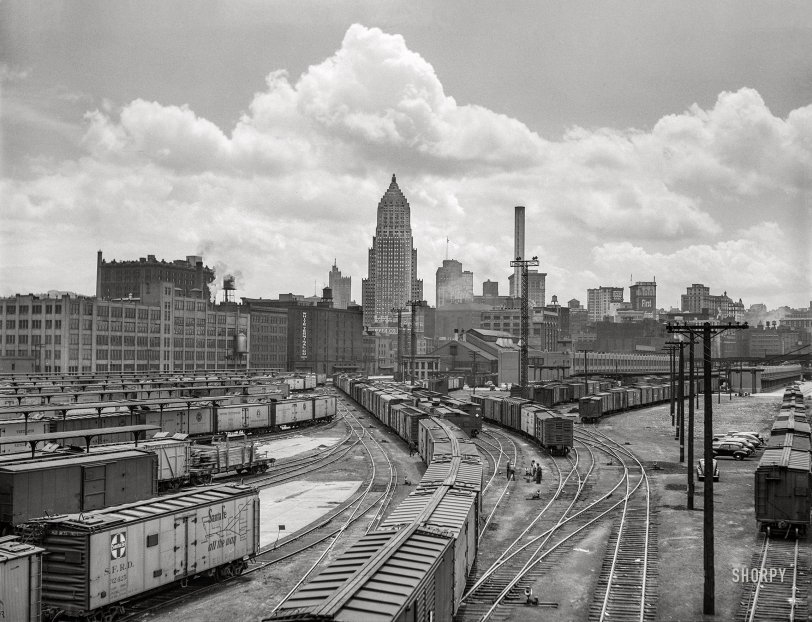


Framed or unframed, desk size to sofa size, printed by us in Arizona and Alabama since 2007. Explore now.
Shorpy is funded by you. Patreon contributors get an ad-free experience.
Learn more.

- Lofty addition
- In 1912
- Keenan Building
- Six years old
- Taken from the P.J. McArdle Roadway?
- It stood only 47 years
- Three track mind
- Incline to the right
- Reach for the sky, 1912 style
- No clean sweep
- Same Job Title, Same Face
- Sadly Lost
- Beautiful ...
- Where you get your kicks
- Aim High
- Pueblo Revival sisters
- Pueblo Neoclassicism
- Milk Man
- Regional dialect.
- Spielberg's inspiration
- Great Photo
- Loaf Story
- Do you still have the Rakes category?
- Could almost be a scene from the 1957 movie 'Hell Drivers'
- The Wages of Fear.
- Conspicuous by their absence
- Got Milk?
- All that aluminum
- No lefties
- Smoke 'em if you've got 'em
Print Emporium
City Terminal: 1941

June 1941. Pittsburgh, Pennsylvania. "Carloads of fruits and vegetables at city terminal." Medium format negative by John Vachon for the Farm Security Administration. View full size.
Lots of Changes
Anyone familiar with the current configuration of Pittsburgh's famous Strip District may find this photo pretty confusing. It took me a while but I think I have it figured out. The row of fairly tall industrial buildings are on the south side of what is now Smallman Street. The White Terminal building and the building just to the left still stand today between 17th and 18th streets, although the White Terminal building has been chopped up a bit.
The long two-story building that extends along the north side of Smallman has to be the famous produce terminal (currently being converted into luxury condos). But that building now extends all the way to 21st Street (just out of the picture on the left) and was somehow reduced to a single story. This is what confused me, and I couldn't find anything on the web that talked about a major change. But a Google Earth view clearly shows that there is a splice in the building right around 18th. So there must have been a major modification after the war when they removed the railroad yard and the terminal switched to purely truck distribution.
Blue Flag
That metal flag clipped to the rail at the lower center of the photo is a "blue flag", so named because, yeah you guessed it, it's blue. Decades before OSHA was invented and created "lock out - tag out" safety rules for machinery in all American industry, the railroads created a similar rule protecting workers on and around locomotives and cars from unintentional movement while servicing this equipment. A blue flag is placed on the approach track, and/or at the controls of a locomotive attached to such cars, to forbid entering that track, or coupling to or moving cars on that track. The switch stand controlling entrance to that track is further locked with a blue painted padlock. Note the track switch is aligned to prohibit entrance to the flagged track. At night, a blue lantern serves the same purpose as the flag. Only the person, or foreman of a group of workers, may remove such as flag or lock.
Each boxcar has a number and paperwork
Railroads "group" freight cars in trains by destination. Each car had (and has) a multi-digit car number. Each loaded car has paperwork called a waybill. Freight train conductors and the switching foremen get copies. A buddy of mine used to work for NY Central and check car numbers of loads placed at an A&P warehouse. The car numbers were six and seven digits long and he said, "Typos mess everything up." So every evening he would get the switch list and trudge through the warehouse sidings "checking numbers." Once in a while he found a mistake but not too often. Nowadays they use computers, computer-generated car lists and scanners in the big freight yards.
Good question!
Which boxcar goes where?
How did they ever figure it out. Either people were a lot smarter or they had more fingers and toes back then.
Gulf Tower
So prominent then at 44 stories, lost in a sea of taller brothers now.
























On Shorpy:
Today’s Top 5